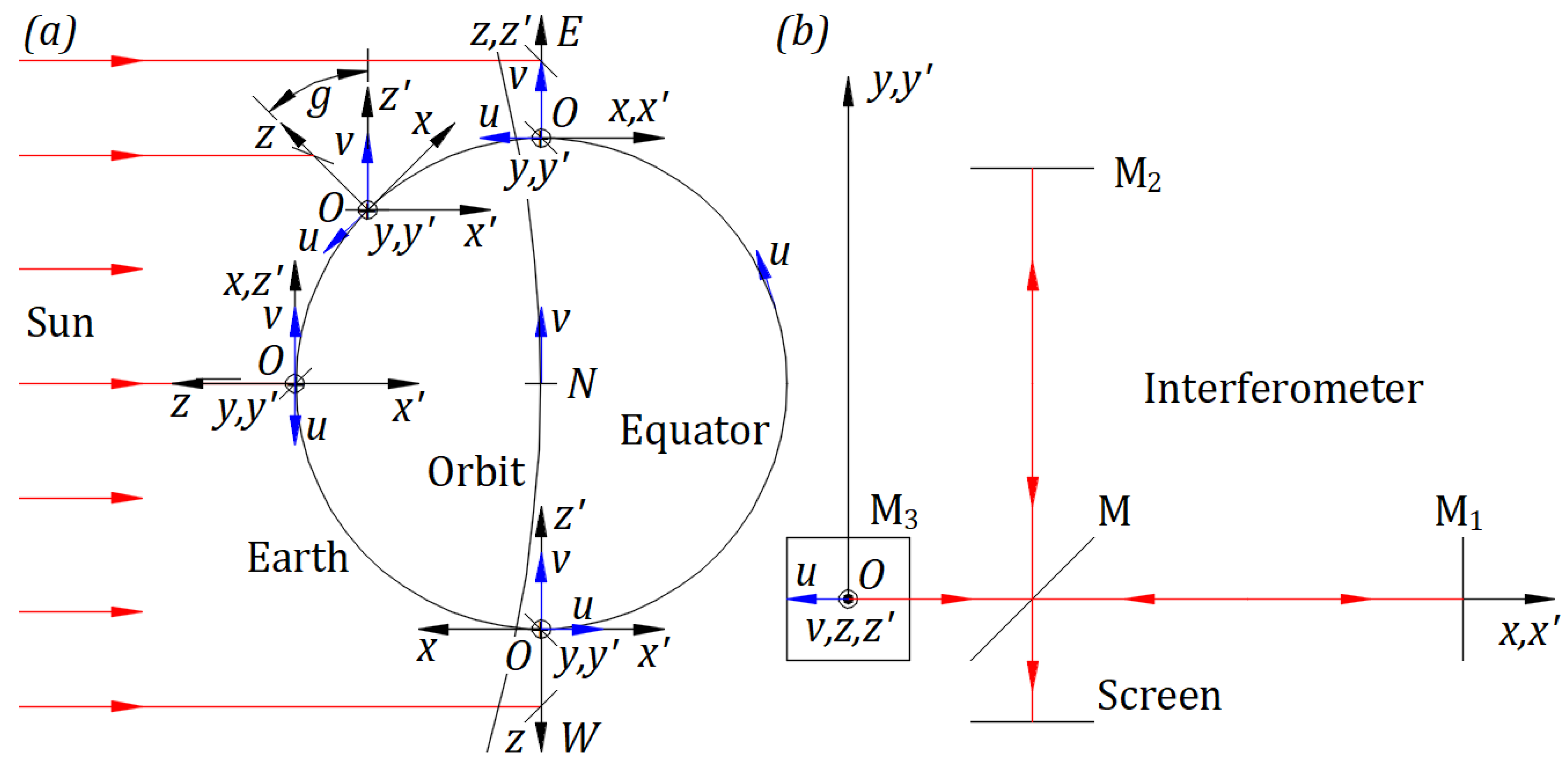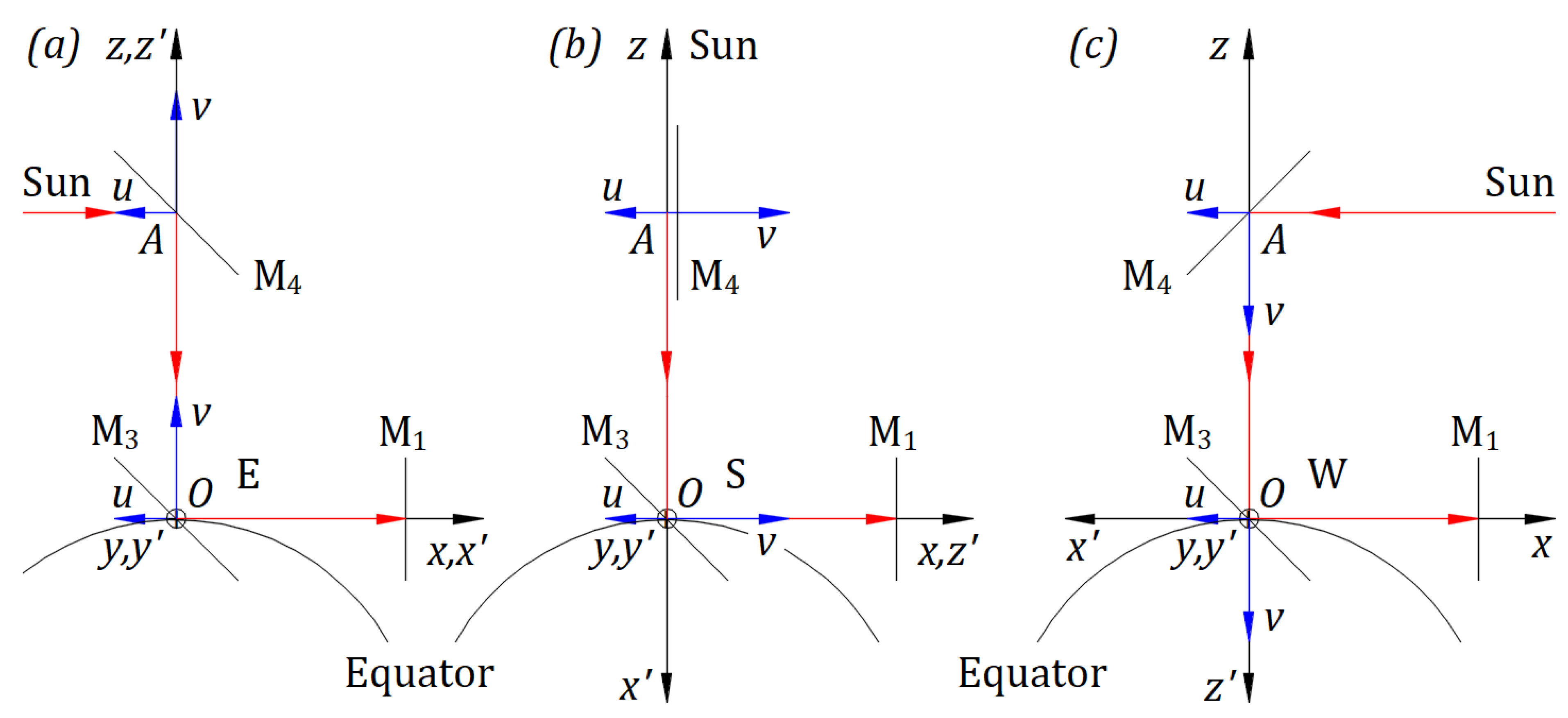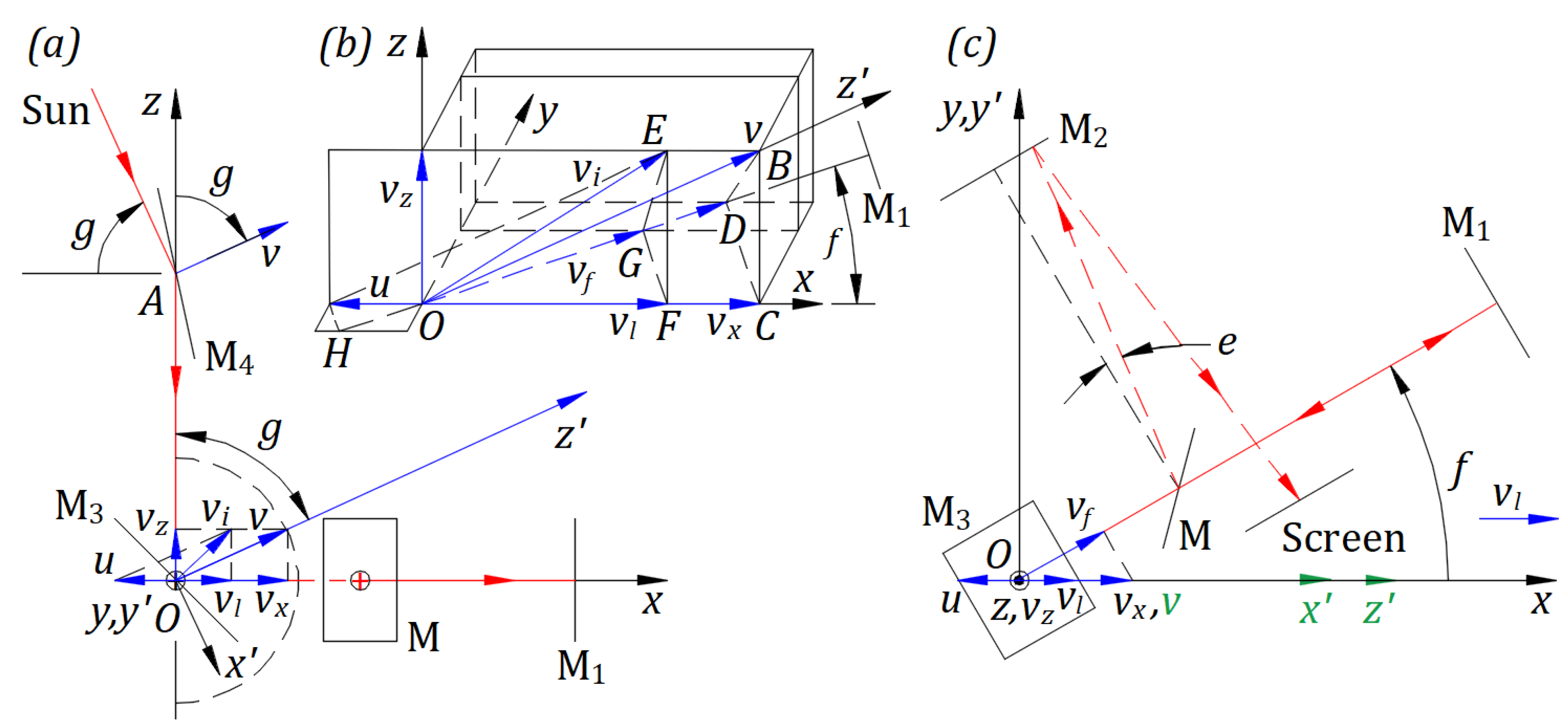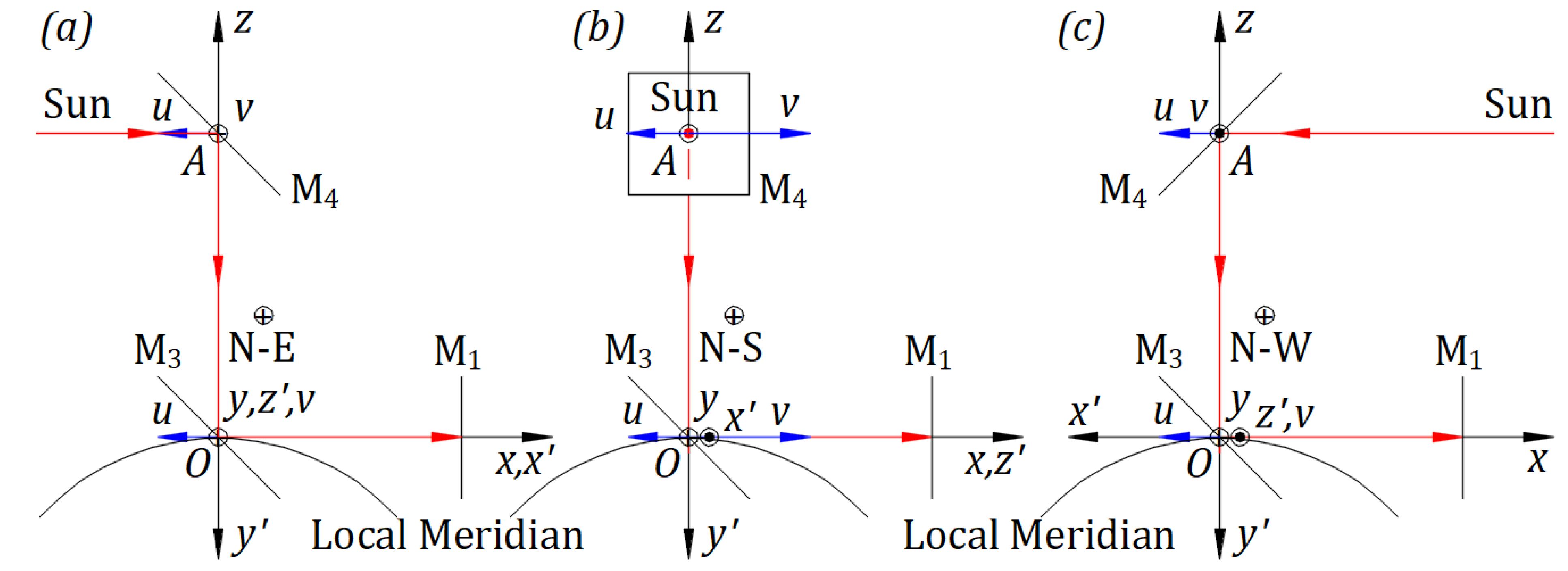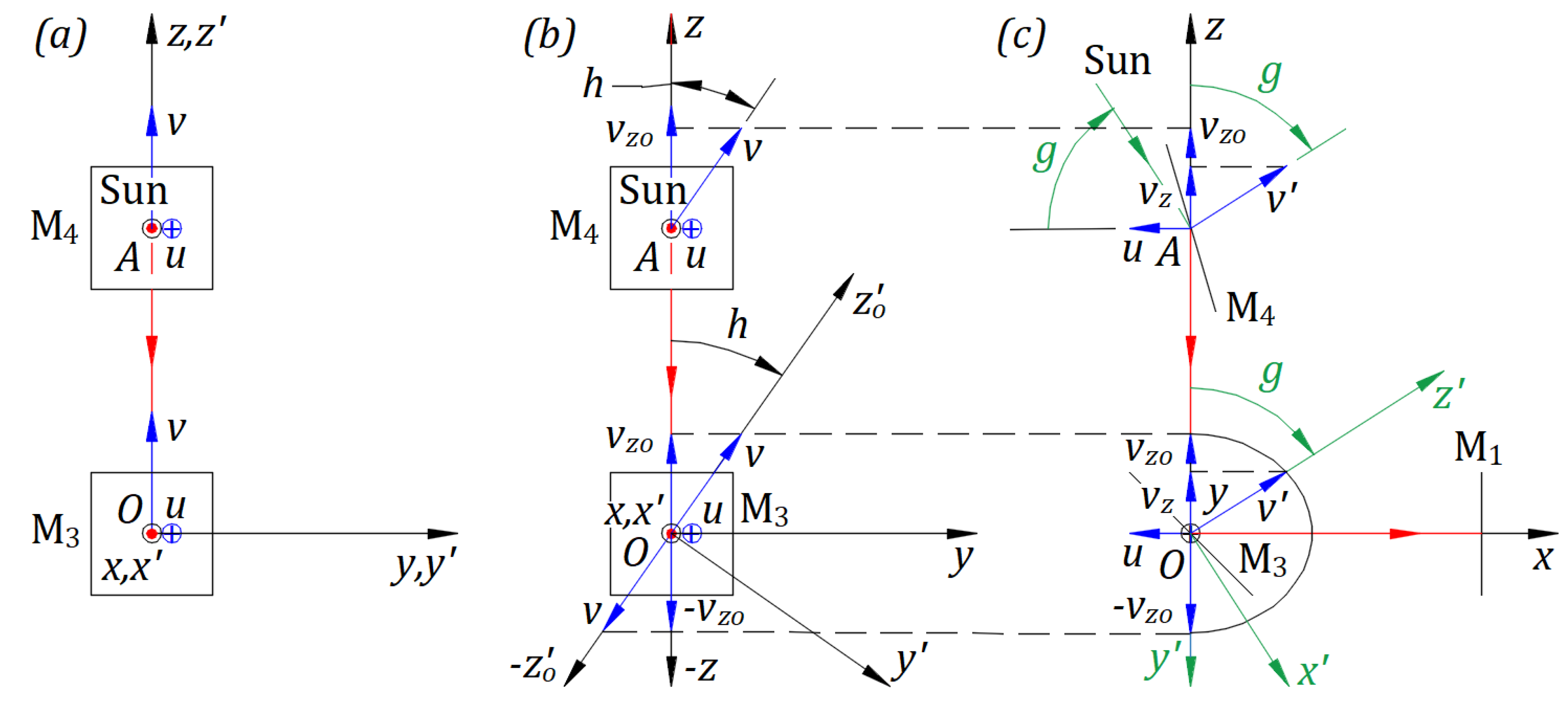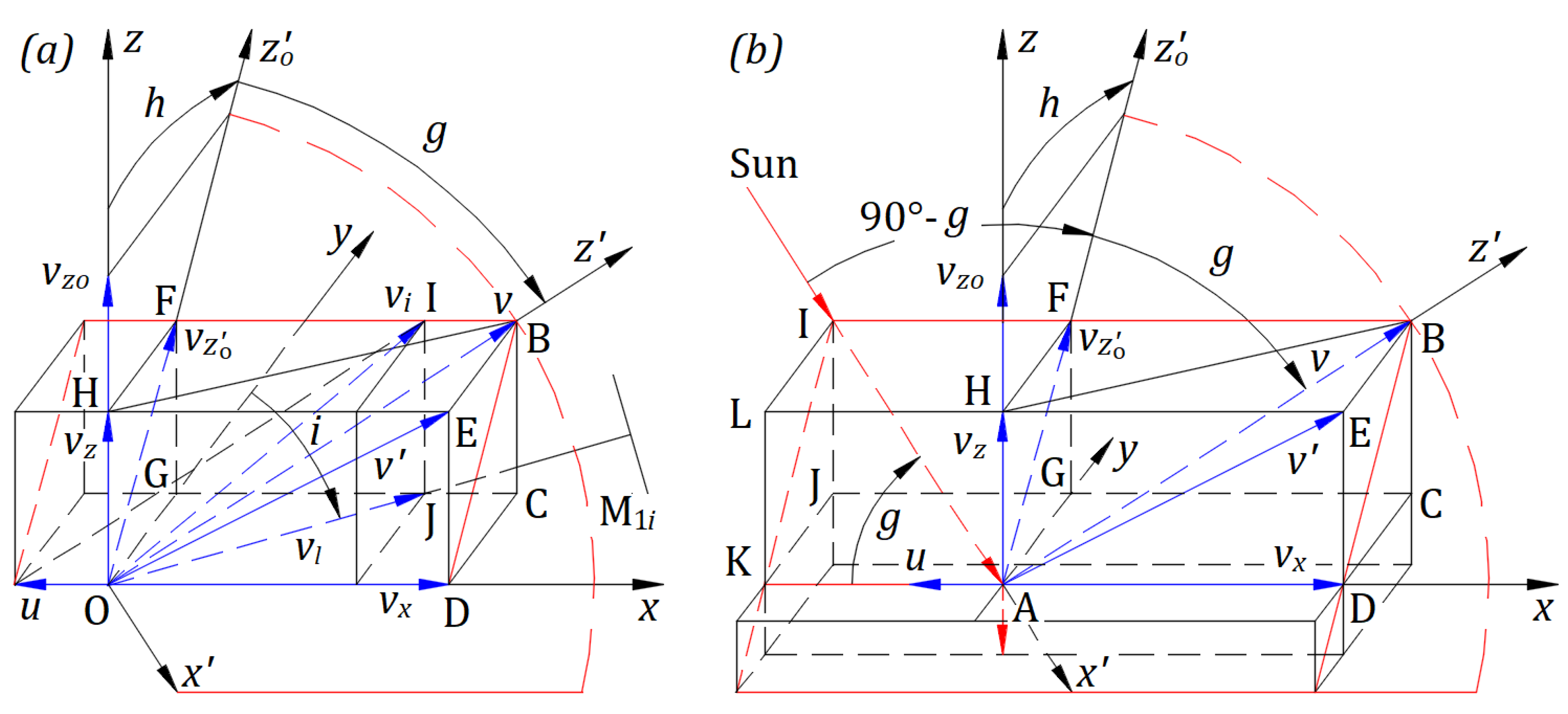1. Introduction
The reflection of light as a mechanical phenomenon [
1,
2,
3] considers the speed of light independent from its moving source and its reflection similar to a ball by a mirror in motion. This study continues with emission, propagation, and reflection of light as mechanical phenomena in inertial frames [
4], observation of a star’s orbit [
5], a general consideration of light reflection [
6,
7], and here with the reflection of light applied to the Miller experiment [
8,
9].
The emission, propagation, and reflection of light in inertial frames [
4] conclude that physics phenomena in an inertial frame can be studied in any other inertial frame considered at relative rest. Here, the Sun’s frame at relative rest replaces the absolute frame for physics studies in Earth’s inertial frame. Thus, the Sun is a fixed light source for Earth, and Earth may be considered an inertial frame in the Sun’s frame at relative rest at the time of an experiment. The light from the Sun travels at the constant speed
in any direction in the Sun’s frame at relative rest.
The reflection of light as a mechanical phenomenon applied to Michelson’s interferometer with a particular geometry [
1,
2] predicts zero fringe shift, and to a geometry [
3] close to that presented in the Michelson-Morley experiment [
10] offers
fringe shift and greater for other geometries. Michelson’s derivation predicts a
fringe shift.
This paper applies the theoretical derivation [
1,
2] and numerical calculation [
3] to Miller’s experiments. Unlike the Tomaschek experiments [
11], the fringe shifts in Miller’s experiments are predictable.
The reflection of light as a mechanical phenomenon [
1,
2,
5] based on the elastic collision of balls with a wall in motion at the limit when the mass of balls converges to zero offers the equation
In Equation (1),
is the speed of a reflected wavefront of a ray of light by a mirror in motion,
is the wavefront speed from the source or a mirror as a source,
is the mirror speed in the opposite direction of the incident wavefront from the source, and
is the mirror speed in the direction of the reflected wavefront. Here, these speeds are in the Sun’s frame at relative rest. The mirror moves in one unique observable direction with speed
. However, regarding the light wavefront, as far as the collision effect is concerned, it has multiple directions of
and
at the moment of collision according to the mirror inclinations. Speeds
and
are projections of
in their corresponding directions.
Another form of Equation (1) is
In Equation (2), the speeds
and
replace
and
in Equation (1), respectively. Angle
corresponds to the opposite direction of the incident wavefront, and angle
to the direction of the reflected wavefront. These angles are measured from the direction of velocity vector
, originating at the point of collision. The directions of
and
are outward from the point of collision.
In the Sun’s frame at relative rest, the velocity of mirrors attached to the Michelson interferometer is affected by Earth’s revolving velocity
around the Sun and Earth’s spin velocities
. Therefore, Equation (1) becomes the equation
and Equation (2) the equation
where
,
,
, and
are the corresponding angle for the incident and reflected wavefront of light for velocity
and
.
Michelson [
10] derives the fringe shift in the space filled with ether. Consequently, the speed of light from a source before and after reflection is the constant
. The study of light reflection as a mechanical phenomenon [
1,
2,
5] occurs in a vacuum. Like a ball in an elastic collision with a wall, the wavefront speed changes after reflection by a moving mirror. Therefore, the difference between these two approaches is the reflection of light by a moving mirror.
2. Interferometer on the Earth’s Equator
2.1. General Considerations
The following drawings illustrate a way to bring the light from the Sun to a modified Michelson interferometer. For simplicity, Earth’s axis has no tilt.
Figure 1(a) illustrates Earth’s equatorial circle, Earth’s revolving orbit around the Sun, and the center of the Sun and Earth in the same plane. The North Pole is outward, and the South Pole is inward, perpendicular to the paper plane.
An observer in the Sun’s frame at relative rest also perceives the physics phenomena as a local observer in Earth’s inertial frame. The observer’s location is on the North side of the Equator.
Figure 1(b) illustrates the Michelson interferometer at 6 am, as seen from the top side of
Figure 1(a). Mirrors M
1, M
2, M
3, and beam splitter M belong to the instrument. Mirror M
3 replaces the instrument’s source of light.
The cartesian frame , fixed to the instrument, originates at point of M3. Axis is on the horizontal line, and axis is perpendicular to Earth’s local surface. Plane is parallel to Earth’s local surface and perpendicular to the local Earth’s radius. At 6 am, the revolving velocity of Earth coincides with .
The interferometer is in plane
. It rotates counterclockwise around
with an angle
measured from
. The initial position of the instrument is when direction
coincides with
for
, as shown in
Figure 1(b).
In the Sun’s frame at relative rest, a vector velocity in the direction of the cartesian frame is attached permanently to the origin of . Earth’s spin changes the origin position of and ; different from , keeps its axes’ directions fixed in the Sun’s frame at relative rest.
The instrument on the Equator belongs to a local Meridian. The Equator’s start position can be defined when: the local Meridian of the instrument is at 6 am, frames
and
coincide, and the device is at the initial position, as illustrated in
Figure 1(b).
In the Sun’s frame at relative rest, the center of the Sun, Earth’s orbit, and the Equator’s circle are always in the same plane. Planes and belong to Equator’s plane. Plane is parallel to Earth’s local surface and perpendicular to Equator’s plane. Axes and are overlapping from 6 am to 6 pm.
Earth’s spin changes the position of . At the same time, in plane , axis rotates clockwise around , keeping the directions of unchanged. with the vector velocity at makes the angle measured from .
Figure 1(a) indicates the position of the interferometer at 6 am, which is the Equator’s start position, corresponding to
. Earth’s spin brings the interferometer to an angle
between 6 am and 6 pm, to
at noon, and
at 6 pm.
2.2. Interferometer on the Equator at 6 am, Noon, and 6 pm
Figure 2(a) depicts the Equator’s start position at 6 am for
. Earth’s spin brings the interferometer at noon, as illustrated in
Figure 2(b) for
, at 6 pm, as presented in
Figure 2(c) for
, and in general, at a time between 6 am and 6 pm, as shown in
Figure 3(a) for an angle
.
Point belongs to mirror M4 and to axis . Mirror M4, axis , mirror M3, and interferometer form a solid structure. Mirror M4 rotates at the Equator around an axis through point perpendicular to . At the North Pole around axis . And between the Equator and the North Pole around both. M4 stays fixed while the interferometer rotates around axis .
Considering that the Sun emits parallel rays of light in the direction from the Sun’s center toward Earth’s center, only these rays are reflected by M4 in the opposite direction to toward M3. The incident rays from the Sun are perpendicular to at any location on Earth.
The vector sum of velocity and offers the moving velocity of the device in the Sun’s frame at relative rest. The instrument has a longitudinal velocity given by velocities and and a transversal velocity only given by velocity at any Earth’s location.
In
Figure 2(a), point
of M
4 reflects the ray of light toward
with the speed
given by Equation (4),
.
The ray reflected at along and for has the speed . With , .
The projection of on is . The rays reflected by M3 drift transversal opposite to velocity .
In
Figure 2(b), the light from the Sun travels perpendicular to
; therefore, no need for mirror M
4. At this position, M
4 rotates
around
to continue reflecting rays for
.
The ray reflected at along and for has, according to Equation (4), the speed .
The projection of on is zero. Thus, there is no transversal drift on rays reflected at M3.
Figure 2(c) shows the device at 6 pm. Point
of M
4 reflects the ray of light toward
with the speed
given by Equation (4),
.
The ray reflected at along and for has the speed .
The projection of on is . The rays reflected by M3 drift transversal opposite to velocity .
2.3. Interferometer on the Equator at an Angle g
Figure 3(a) presents the instrument between 6 am and 6 pm when
makes an angle
measured from
. To reflect the rays in the direction
, M
4 rotates around the axis through point
and perpendicular to
. Angle
has an opposite direction to Earth’s spin.
From 6 am to 6 pm for
, projection of
on
is the transversal speed of the instrument in the Sun’s frame at relative rest
Projection of
on
,
, offers the equation
In
Figure 3(b), the vector sum of velocities
and
, shown in the plane
, is the moving velocity
of the device in the Sun’s frame at relative rest.
and
are equal to
for any angle
. The projection of
and
are
and
, respectively.
is the longitudinal component of velocity
for the instrument.
and are perpendicular to for any angle . and planes and their intersection along are perpendicular to , and is perpendicular to . Therefore, is perpendicular to plane , and is perpendicular to . Thus, the projections of and on are identical to . With the same reasoning, the projections of and on are identical to . Point belongs to , and that vary with angle .
The longitudinal speed of the instrument in the Sun’s frame at relative rest
then, with
from Equation (6),
Figure 3(c) illustrates the top side view of
Figure 3(a) with the interferometer rotated by an angle
from
. For the geometry presented in Ref. [
3], reflected rays by beam splitter M travel as illustrated at an angle
from the perpendicular line to M
2.
,
and
in green indicate that they are not in plane
.
Point
of M
4 reflects the ray of light toward
with the speed
that gives the equation
The ray from
reflected at
along
, employing Equation (4), has the speed
. The term
is according to
Figure 3(a) and
3(b), and
to
Figure 3(b) and
3(c), both at
. With
from Equation (8) and
from Equation (7),
yields the equation
With the same reasoning as for
, the reflected speed of light at
along
at an angle
is
.
3. Interferometer on the North Pole
The solid structure, illustrated in
Figure 2(a), brought from the Equator at 6 am along the local Meridian at the North Pole, looks like in
Figure 4(a). From the Equator to the North Pole, the frame
rotates
in the Sun’s frame at relative rest. In plane
,
rotates
around
from
to
; after rotation,
has the same direction as
. Planes
and
coincide and are parallel to Equator’s plane. Axis
is perpendicular to Equator’s plane.
Earth’s spin rotates
in the Sun’s frame at relative rest. In plane
,
rotates around fixed
from
at 6 am at angle
, as illustrated in
Figure 4(a), to
at noon at angle
, as in
Figure 4(b), and to
at 6 pm at angle
, as in
Figure 4(c). At the North Pole, mirror M
4 rotates only around
.
4. Interferometer on a Latitude
The right side view of
Figure 2(a), ignoring M
1, is as in
Figure 5(a). Moving the solid structure from the Equator toward the North Pole,
rotates in the Sun’s frame at relative rest. Velocity
with its axis
rotates in plane
around
with angle
measured from axis
, as visualized in
Figure 5(b). For
, the interferometer is at the Equator, and for
at the North Pole. In the rotation on a Meridian, from the Equator to the North Pole, Mirror M
4 stays fixed.
In
Figure 5(b), we can define the Latitude’s start position at the intersection of the local Meridian with the local Latitude at 6 am.
is marked with index o for angle
,
, and is in plane
making an angle
measured from
.
Plane is parallel, and axis is perpendicular to Equator’s plane here and at any location on Earth. Plane is parallel, and the axis is perpendicular to Earth’s local surface as on any place on Earth. and are perpendicular to plane and intersect along .
Earth’s spin rotates the frame on the Latitude from 6 am to 6 pm. At the same time, velocity with its axis rotates around fixed axis from at 6 am for angle to at noon for and to at 6 pm for . Thus, on a Meridian, angle is identical when the instrument is on different Latitudes to that at the Equator. On a Latitude, mirror M4 rotates around both axes to capture only the parallel rays from the Sun.
The view from the opposite direction of
shows vector
with its axis
rotating from 6 am to 6 pm on a semicircle with origin at
and radius
. The semicircle is in plane
. Any angle
yields an identical image. The semicircle is identical to that in
Figure 3(a), illustrated in a dashed line in plane
.
The view from the opposite direction of
sees the semicircle projection of the vector
as a semi-ellipse in plane
, as illustrated in
Figure 5(c). The projection points of this semi-ellipse on
represent the speeds
for angles
.
Figure 5(c) is the left side view of
Figure 5 (b) for an angle
measured from
. The projection of the velocity
that belongs to
on plane
is
.
,
, and
axes are depicted in green to indicate that they are not in plane
;
is in the front, and
and
are in the back of plane
.
Planes and intersect along . coincides with only at . Axis rotates in the back of plane from at the Latitude’s start position when it is behind for to plane coinciding with for . Then rotates in front of plane to for , above . rotates in front of plane from for to above for , then to for .
Figure 6(a) offers a three-dimensional visualization of the mechanical velocities at point
of
Figure 5(c). Axis
is in plane
. Rectangular
belongs to
,
to
, and
to
. The speed
is along axis
. Index
for
indicates that mirror M
1 location corresponds to angles
defined below. Velocities
,
, and
belong to rectangular
of the plane in red;
and
to plane
.
The projection of
on
at the Latitude’s start position offers the equation
The projection of
on
is
, therefore,
The projection of
on
,
, is also the projection of
on
. Employing Equation (12),
The contribution of on is zero at all times; therefore, is the transversal speed of the instrument in the Sun’s frame at relative rest.
The projection of
on
is
, therefore,
The vector sum of velocities
and
is the instrument velocity in the Sun’s frame at relative rest
. Angle
and from triangle
, the cosines theorem yields the magnitude of velocity
that yields the equation
The projection of
on
also is
from Equation (13). The triangle
gives the projection of
on the plane
,
that is the longitudinal speed of the interferometer in the Sun’s frame at relative rest.
, then
, then in triangle
,
that offers the equation
Angle indicates the interferometer’s initial position direction when and directions coincide.
Figure 6(b) offers a three-dimensional visualization of the mechanical velocities at point
of
Figure 5(c). At
, we can attach the same frame as at
,
, and
. Axis
is in plane
. Velocities
and
belong to rectangular
with its sides in red, which belongs to
. The ray from the Sun travels in this plane along the line
. Point
of M
4 reflects it towards
. M
4 must be adjusted with both axes to reflect the incident ray at
along
’s direction towards
.
The ray of light reflected at
toward
has the speed
that gives the equation
From
Figure 6(a), we can calculate the speed of light reflected in the direction
for angle
,
.
from Equation (16) includes both
and
contributions along
. Thus, term
, and then
that offers the equation
For the same reason as in
Figure 3(b), the projections of
and
are identical for any angle
measured from
. The speed of light reflected at
in the direction of
for an angle
measured from
is
that yield the equation
5. Numerical Calculation of the Fringe Shift
For the length
m of the interferometer’s arms, Miller expected a
fringe shift based on Michelson’s derivation [
10] and observed, at Mount Wilson,
in 1921 and
in 1925 [
8,
9]. The observations taken in the laboratory at Cleveland 1924, with sunlight and laboratory sources, show a null result of experiments. The above discrepancy in experimental results requires a theory to support it or a reevaluation of Miller’s experiments.
The velocity is the moving velocity of the instrument in the Sun’s frame at relative rest. The device has the longitudinal velocity at Equator and on a Meridian parallel to and the transversal velocity perpendicular to plane . To correctly calculate the fringe shift within the interferometer, we have to consider both velocities, but there is no such theoretical derivation.
In the following derivation, we assume that the fringe shift is not affected by the transversal speed
, and we calculate the fringe shift for the four positions offered by Ref. [
3].
The numerical calculation can be performed on a spreadsheet according to the theoretical derivation of Ref. [
3], starting with the set of speeds
,
,
,
, and
, followed by the times the light travels its paths and their differences, and finally, the fringe shift, for each of the four positions at angle
,
, and
.
The initial position of the interferometer for
corresponds to the
position in Ref. [
3] because between the two selected initial positions, there is a difference of
. Thus, for
,
,
, and
positions correspond to
,
,
, and
positions in Ref. [
3].
The speed
from Equation (20) replaces the speed
correspondingly in the sets of speeds
,
,
,
, and
in the four positions as defined in Ref. [
3]. The numerical magnitude of speed
from Equation (16) replaces speed
in all four positions of Ref. [
3], including in the sets of speeds mentioned above.
In Ref. [
3], rays along the screen interfere because their speeds,
and
, are equal. Ref. [
3] derives the difference between the two light paths in the number of wavelengths
with formula
, where
is the difference of time the two rays travel their paths with the same or different speeds,
is the constant
m/s, and
the wavelength of light for constant
.
If the speed of the two interfering rays increases or decreases, their wavelengths increase or decrease directly proportional. Therefore, the ratio speed/wavelength is a constant for any of their corresponding speeds/wavelengths. Therefore, are not affected by the speed magnitude of rays that interfere along the way to the screen. Thus, no need to change the formula .
For any location on Earth, the numerical calculation of the fringe shift, for m, predicts unobservable fringe shifts in the range. For m, the fringe shift is in the range of . The rays reflected by M4 coming from different points of the Sun, or corresponding to different altitudes, or magnitudes of angle greater than aberration angle do not change the result of the fringe shifts.
In Ref. [
3], different from this article, the source of light is a part of the interferometer belonging to Earth’s inertial frame. For
m, the fringe shift is
, and for
m, the fringe shift is
. According to emission, propagation, and reflection of light as mechanical phenomena in inertial frames [
4], the fringe shift in the Michelson interferometer is zero.
5. Conclusions
With the assumption that the transversal velocity of the interferometer does not affect the fringe shift, Michelson derivation does not agree with Miller’s experiments at Mount Wilson in 1921 and 1025 and with those at Cleveland laboratory in 1924. The derivation based on the reflection of light as a mechanical phenomenon does not agree with Miller’s experiments at Mount Wilson but agrees with experiments at Cleveland laboratory with sunlight and laboratory sources.
When the local meridian is at noon, from the Equator to the North Pole, there is no transversal speed for the instrument, and the numerical calculation yields zero fringe shift. Miller observed fringe shifts at Mount Wilson for these positions as well. Therefore, a derivation considering the transversal speed should not affect the fringe shift for these positions and is not likely for any position of the instrument on Earth.
For any angle , the speed of light , and the longitudinal speed of the interferometer is . Thus, the speed of light within the interferometer is , which could explain why the fringe shift is zero or undetectable.
The Tomaschek experiment [
11] may display a fringe shift if the star’s velocity in the Universe is different from that of the Sun. The light from a star arrives on Earth, no matter the distance from the star to the Sun, with two components: the emitted velocity
and the star’s velocity [
4,
5]. The fringe shift depends on the difference of star and Sun velocities. Experiments consist of trials and observations with different stars without any expectations. Nevertheless, the theoretical derivation is more complex, even if we know the star’s velocity to the Sun.
However, regardless of the outcome of a complete theoretical derivation, the contradictory results observed at Mount Wilson and the Cleveland laboratory leave this subject open to theoretical and experimental challenges.
Ref. [
3] offers zero fringe shift for
rad,
for aberration angle
rad, and greater than
for an angle
beyond the aberration angle. We chose a geometry for theoretical derivation and calculation of the fringe shift, but an experiment yields a fringe shift according to an unknown geometry. The author expected this study to predict Miller’s observations at the Mount Wilson and Cleveland laboratory because different actual geometries of the interferometer’s light paths, which imply different angles
, could explain the observations at the two locations.
References
- Filipescu, F. D. Reflection of Light as a Mechanical Phenomenon Applied to a Particular Michelson Interferometer. Preprints 2020, 2020090032. [Google Scholar] [CrossRef]
- Filipescu, F. D. Opposing hypotheses of the reflection of light applied to the Michelson interferometer with a particular geometry. Phys. Essays. 2021, 3, 268–273. [Google Scholar] [CrossRef]
- Filipescu, F. D. Opposing hypotheses of the reflection of light applied to the Michelson interferometer. Phys. Essays. 2021, 3, 389–396. [Google Scholar] [CrossRef]
- Filipescu, F. D. Emission, propagation, and reflection of light as mechanical phenomena in inertial frames. Phys. Essays 2021, 34, 587–590. [Google Scholar] [CrossRef]
- Filipescu, F. D. Observation of a star’s orbit based on the emission and propagation of light as mechanical phenomena. Phys. Essays. 2022, 2, 111–114. [Google Scholar] [CrossRef]
- Filipescu, F. D. Emission, Propagation, and Reflection of Light as Mechanical Phenomena. Preprints 2022, 2022040061. [Google Scholar] [CrossRef]
- Filipescu, F. D. Emission, propagation, and reflection of light as mechanical phenomena: General considerations. Phys. Essays. 2022, 3, 266–269. [Google Scholar] [CrossRef]
- Miller, D. C. Ether-Drift Experiments at Mount Wilson. Proc. Natl. Acad. Sci. U. S. A. 1925, 6, 306–314. [Google Scholar] [CrossRef] [PubMed]
- Miller, D.C. The Ether-Drift Experiment and the Determination of the Absolute Motion of the Earth. Reviews of Modern Physics. 1933, 5, 203–242. [Google Scholar] [CrossRef]
- Michelson, A. A.; Morley, E. W. On the relative motion of the earth and the luminiferous ether. Am. J. Sci. 1887, 203, 333–345. [Google Scholar] [CrossRef]
- Tomaschek, R. Über das Verhalten des Lichtes außerirdischer Lichtquellen. Ann. Phys. 1924, 378, 1-2, 105-126. [CrossRef]
|
Disclaimer/Publisher’s Note: The statements, opinions and data contained in all publications are solely those of the individual author(s) and contributor(s) and not of MDPI and/or the editor(s). MDPI and/or the editor(s) disclaim responsibility for any injury to people or property resulting from any ideas, methods, instructions or products referred to in the content. |
© 2023 by the authors. Licensee MDPI, Basel, Switzerland. This article is an open access article distributed under the terms and conditions of the Creative Commons Attribution (CC BY) license (http://creativecommons.org/licenses/by/4.0/).
